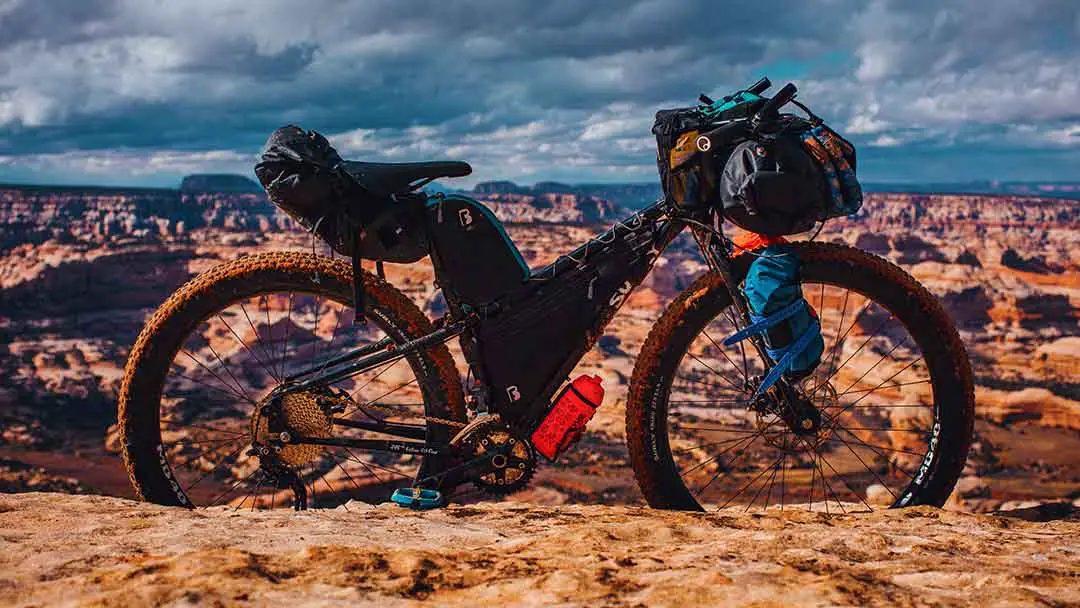How To Convert A Mountain Bike To Touring Bike (7 Step Process)

As an Amazon Associate we earn from qualifying purchases made on our website. If you make a purchase through links from this website, we may get a small share of the sale from Amazon and other similar affiliate programs. You can read our complete legal information for more details. By using this site, you agree the information contained here is for informational purposes only. For specific medical questions, consult your doctor. NO information on this site should be used to diagnose, treat, prevent or cure any disease or condition.
Mountain bikes have always been my favorite kind of bike. They’re sturdy yet lightweight and create the best experience when off-road biking. But can they be modified for cycle touring?
You can convert a mountain bike for cycle touring, but you can’t change the metal which makes the frame. You should replace the seat and tires and add luggage carriers. We recommend using a steel-frame mountain bike for touring, but if you can’t find one, you can still use it for short distances.
These are the seven steps to convert your bike for touring!
What Are the Differences Between a Mountain Bike and a Touring Bike?
Weight and weight capacities are the main differences between mountain and touring bikes.
Mountain bikes are light bikes with smaller frames designed to make climbing slopes easier.
Touring bikes are made of heavy metals with extra bulk to carry luggage over long distances.
The main differences between mountain and touring bikes include weight, material, and purpose.
Mountain bikes can handle winding paths and uphill climbs easier than other bike designs.
Mountain bikes are more versatile than other bikes. But they’re designed for rugged mountain paths, which is where they shine.
An unmodified mountain bike doesn’t handle straight, paved roadways as well as other biking styles. Mountain bikes can be used on roads for commuting and other travel purposes, but the shape is not ideal.
Mountain bikes are sleek and light, although they are heavier than road bikes. This is because they are intended to be ridden in mountains and forests off the road. This can make them difficult for long commutes on roadways.
The main discomfort of riding a mountain bike for touring is the position of the handlebars.
Handlebars on a mountain bike are designed to be aligned with the bike seat. This is ideal for climbing and descending mountains but is uncomfortable on flat ground for long distances.
Touring bikes, however, are designed to be heavier and more ergonomic. Since they’re meant to be ridden for dozens of miles daily, they need to be sturdier and more comfortable.
Additionally, they have more space for carrying luggage. In the front of the bike wheel, touring bikes usually have bars for holding bags, water bottles, or other containers for supplies.
Mountain bikes aren’t designed to carry supplies and luggage. They’re usually made with light metals like aluminum which is great for mountain biking but isn’t suitable for touring.
Most bikers agree that steel is better than aluminum and carbon for touring.
While there are many reasons for this preference, the main reasons are steel’s durability and ease of repair.
Steel frames are much easier to weld and repair on the road. If your bike’s frame cracks or gets weakened, you can take a steel frame bike to a repair shop and have it fixed.
Aluminum is tough to fix, and if your bike breaks, it can be almost impossible to repair in a pinch.
Side note: if you plan on adding more water bottle holders without drilling holes, this is how to do it!

Why Would You Want to Use a Mountain Bike as a Touring Bike?
Mountain bikes are strong, lightweight, and durable. They’re more easily converted to touring bikes thanks to their robust build and larger frames.
This makes them better than road bikes and thin-framed bikes, which are virtually impossible to convert into touring bikes.
The benefits of using a mountain bike for touring include the following:
- Large tires withstand wear and tear
- Sturdy frames
- Large frames
- Good suspension
Each of these features is necessary for a smooth ride over long distances. The frame can withstand bumps in the road and other intense roadway disruptions, which will jolt it.
This makes the ride steadier and prevents damage to the bike.
The tires are perfect for long distances as well. They have a thick wall that helps prevent nails, rocks, and sharp objects from puncturing the tire.
The best touring tires are puncture resistant, have wide treads, and resist wear.
The negatives of using a mountain bike for touring include the following:
- The height of the handlebars
- The shocks in the front and back
- The lack of racks and bars for holding luggage
- The shape of the seat
- The pedals
- Some are made of aluminum and not carbon or steel
The good news is most of these shortcomings can be addressed. You can adjust your bike, making it suitable for riding across the country.
How to Select a Mountain Bike to Convert for Touring
Certain kinds of mountain bikes are better for touring than others. Hardtail mountain bikes are the best option since they only have suspension in the front, not dual suspension.
Bike dual suspension is excellent for mountain biking since it helps it adapt to the various bumps in terrain.
However, it can make cycling on roadways uncomfortable and disruptive. The constant jostling over the roadway every time you hit a bump can wear you out quickly.
Ideally, find a mountain bike from the mid-1990s or early 2000s. Older bikes were made from steel, which, as we discussed, is ideal.
If your mountain bike is made of aluminum, there’s no way to modify it so it can withstand touring.
However, most other features are adjustable. We have the steps for you to take to prepare your mountain bike for touring.

Steps to Convert Your Mountain Bike
1. Change the Handle Bars
Most bike handlebars are adjustable and can be shifted to a person’s height and needs. However, many mountain bikes favor a low-set handlebar that aligns the seat with the bars.
This is great for power riding. Most mountain bikes are meant to be ridden for short rides.
You might ride them for several hours a day, but it can be painful to ride them for several days straight.
These are the basic steps to replace your current handlebars:
- Find the ideal handlebars for your needs
- Unscrew the current handlebars
- Remove the stem
- Replace the current brakes with road brakes
- Replace old stem with drop bar stem
- Add new handlebars
- Adjust brakes
To watch a full, how-to video, check out this video by RJ the Bike Guy.
2. Replace Mountain Bike Tires
We talked about how mountain bikes are better for roadways than other bike tires for long-distance rides. However, there are better types of tires for touring.
By far, touring tires are the best type of tire for touring. This is because mountain tires are designed for rocky terrain. Their thick tire treads were made to withstand constantly shifting landscapes.
This can make them challenging to handle on roadways. You should find a good, smaller tread tire for touring since they manage better on paved surfaces.
Replacing your tire is relatively easy since the size of the tire base is the same. To remove your old tire, follow these steps:
- Deflate the old tire
- Store the air cap in a safe place
- Remove the old tire and tube
- Replace with a new tube
- Always inflate the tube before putting the tire on
- Use the tire tool to put the tire on over the tube
- There should be no holes or cracks between the base and the tire

3. Install Racks and Other Luggage Carrying Devices
Luggage and storage compartments are vital for cycle touring. You should have enough space to accommodate the following supplies:
- 2-3 days’ worth of food
- 1-2 days’ worth of water
- Three pairs of changing clothes
- Sleeping bag
- Shelter (tent, hammock, tarp, etc.)
- Survival tools (fire starters, water purification tablets, first aid kit, etc.)
You can download our free Bike Touring Packing Checklist in PDF format here.
This can be very tedious to carry around with you on your back and body. It would be best if you had the tools on your bike to hold panniers, bags, and water bottles.
While you can’t adjust your bike’s frame, you can add holders to your mountain bike. Add plastic holders on the front rack (you can even use them to hold a biking drone), back frame, and low and top bar containers.
Something like the Rock Bros back storage bags is excellent. They create extra storage space on your mountain bike, which you wouldn’t have otherwise.
Before we move on to the next modification, I do want to mention that Voile Straps come in handy for almost any bike adventure. Please read this article to see what I’m talking about.
4. Install Fenders For Mud and Debris
Fenders aren’t usually included on mountain bikes because they’re considered unnecessary. Fenders, also known as mud guards, prevent water and mud from damaging the bike’s chain.
On mountain bikes, fenders are loud, cumbersome, and disruptive to the bike’s performance. This is true for mountain biking for several reasons.
For example, most people don’t use mountain bikes when it’s raining. This makes mud guards somewhat redundant because they’re mostly designed for use in muddy areas.
However, mudguards are necessary for cycle touring. You have no way of knowing for sure what to expect during a cycle tour which can last weeks, if not months.
You can hire a bike mechanic to add these fenders, or you can apply them yourself.
Although you might need to use welding tools depending on the type of fender, you purchase.
5. Replace Pedals for Clipless
Clipless pedals are more adjustable than flattop pedals. Flat pedals are better for mountain bikes because they handle more steadily and don’t jostle as much when going downhill.
However, they’re not good for smooth roadways where there’s little resistance. They create resistance when pedaling and thus make pedaling harder.
Replacing pedals is easier than other parts of the bike. Most pedals are simply screwed in place and thus can be unscrewed by spinning the pedal.
Once the pedals are removed, you can screw the new pedals in place.

6. Install Water Holders
Water holders are essential for holding your water supply. We don’t recommend using backpacks to hold your water for two reasons:
- It creates strain on your back
- It is difficult to reach your water bottles while on the road
You want easy access to your water while you’re riding. Otherwise, you’ll have to stop your bike and pull the water out of your backpack every time you’re thirsty.
Additionally, you want to prevent dehydration. If the water is hard to get to, you might find yourself delaying water breaks which can cause dehydration.
I wrote the guide on bike water storage: The Bikepacking Water Storage Guide.
7. Get a More Comfortable Bike Seat
Finally, you’ll want to replace your bike seat. Mountain Bike seats are designed to be aerodynamic and enhance speed. But they’re not designed for comfort and aren’t the best for long-distance biking.
If you use a traditional mountain bike seat for long-distance cycling, you’ll probably end up with sores and bruises on your bottom.
It can also cause chaffing on your legs, especially in the thigh region.
We recommend switching your seat for a touring seat or using a cushion.

Do You Need to Replace the Bike Frame on a Mountain Bike for Touring?
You don’t necessarily need to change the bike frame to convert a mountain bike for touring.
You should try to find a mountain bike made of steel rather than one made from aluminum. Alternatively, you can use a mechanic to modify your bike, but this might be more costly than buying a new bike.
As we briefly touched on earlier in this article, steel frames are best for touring. If you have a steel frame, it can be easier to repair and replace broken parts of your bike frame.
If you only have an aluminum frame bike, there are a few things you can do. The most important step is to refrain from taking tours in rural and underdeveloped areas.
Word of advice, don’t use your aluminum frame bike if you’re planning to bike through the Andes in South America.
An aluminum frame should be fine if you’re planning to bike through an open yet developed area.
You want to make sure you’re close to public transportation in case your frame breaks!
Closing Thoughts
Mountain bikes are sturdy and well-loved for good reasons! They’re easily adjusted and modified to meet the needs of almost any kind of cycling!
We hope you found this step-by-step guide helpful. Modifying your mountain bike doesn’t have to be complicated; it just has to be done right.
Replace the old seat and pedals, and add some extra storage space! After some adjustments, your mountain bike should be prepared for touring.
Free Bike Resources:
- 11 Best California Bikepacking Routes
- How To Select Gears for a Touring Bike
- Complete Bike Touring Cooking Guide
Sources:
Bicycle2Work: Touring Bikes Versus Mountain Bikes – 13 Differences
Discerning Cyclist: Are Mountain Bikes Good for Commuting? [PROS + CONS]
Bike Radar: What is a touring bike?
Bike Radar: Bike frame materials explained: carbon vs aluminium vs steel vs titanium
Biking Universe: Are Mountain Bikes Suitable for Road Touring? Here’s Why
Bike Hike Safari: Best Bicycle Touring Tires
Cycle Scope: Mountain Bike Touring – The MTB Set-Ups for Bikepacking & Cycle Camping
Bike Lock Wiki: What Is a Hardtail Bike?
Bike Radar: How to adjust the handlebar height on your bike
Mantel: How to replace your MTB or road bike handlebars [How-to]
YouTube: RJ the Bike Guy: Convert Mountain Bike To Drop Bars for Touring/Monster Cross/Gravel Bike
Decline Magazine: Can I ride my mountain bike on pavement
YouTube: Park Tool: How to Patch a Bicycle Inner Tube
Two Wheels: Your Bike Probably Needs Fenders (But Here’s How To Know)



